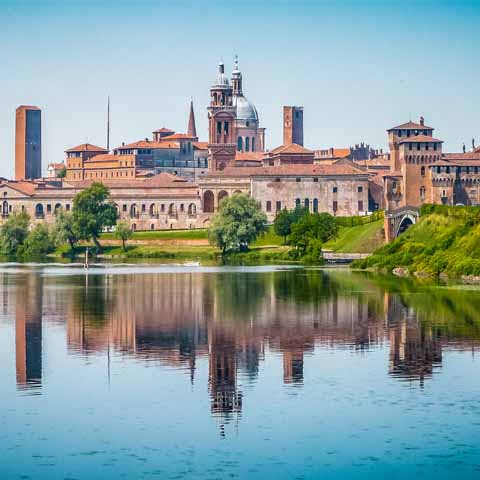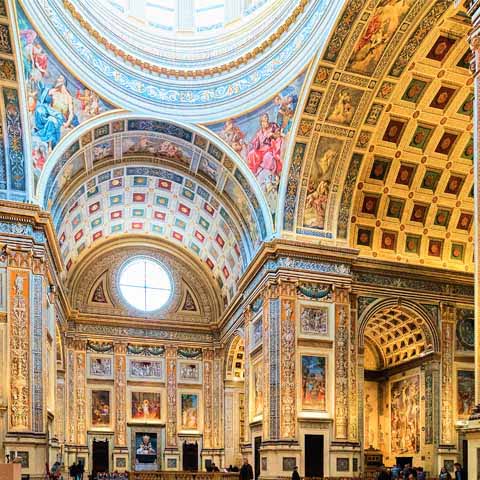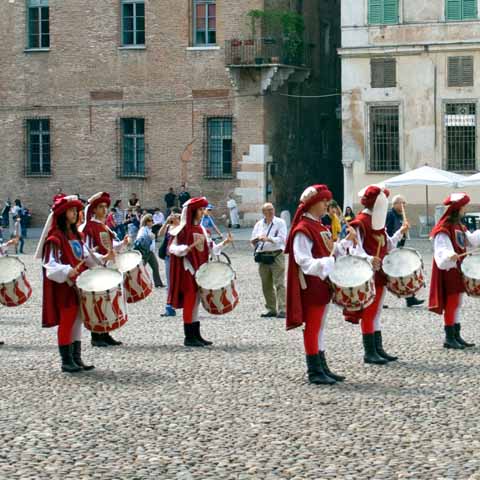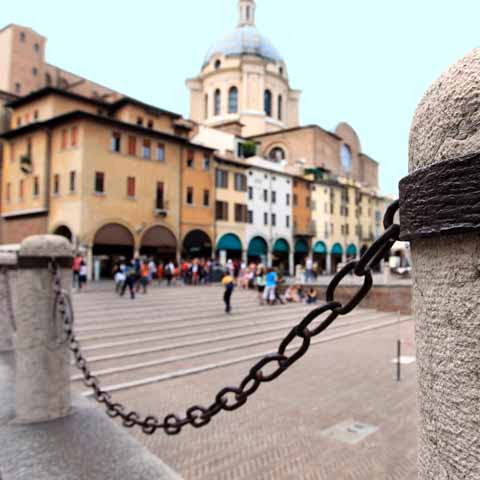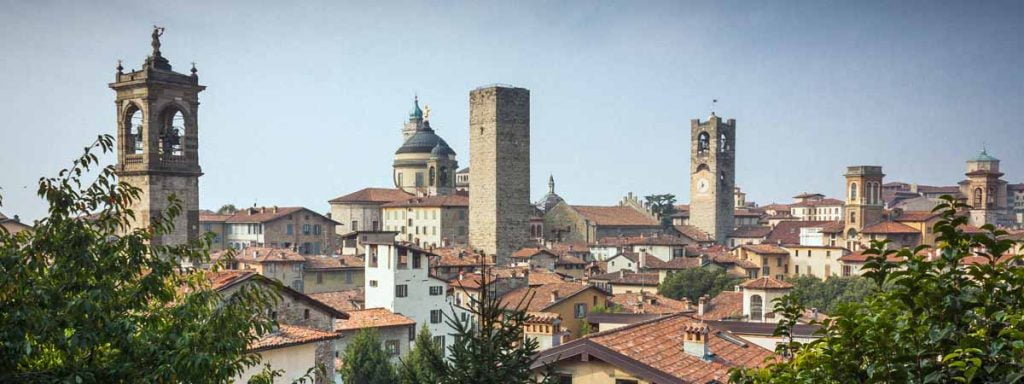Mantua, the capital of the homonymous province in Lombardy, is a small city counting less than 50,000 souls. But despite its rather reduced dimensions, the municipality enjoys a rich history and high cultural prestige.
Since 2008, Mantua was named one of the art cities in Lombardy. The legacy left here by the Gonzaga continues to live on as the family transformed the city into one of the main centers of the Italian and European Renaissance and is now part of UNESCO’s World Heritage sites.
Named the Italian Capital of Culture in 2016, Mantua and its province are also part of the European Regions of Gastronomy, together with other cities in Lombardy including Brescia, Bergamo, and Cremona.
Besides all these national and international awards, it’s safe to say Mantua is the only city that incorporates a widespread urban museum.
Such an avant-garde city can only have ancient roots and a rich history. The myth of the foundation of the city is closely linked to the story of the prophetess Manto who, according to the Greek tradition, fled from Thebes and after long wandering, found a completely marshy territory where she would raise the future city of Mantua.
According to the legend, Mantua rose on the place where she created a lake made from tears whose waters had the magical property of conferring prophetic abilities to those who drank them.
It is easy to understand the name of the city derives from the prophetess’ name. Renowned since the earlier times, the myth of the foundation of the city is found in Virgil’s Aeneid as well as in Dante’s Divine Comedy.
Tradition and myths apart, a more probable explanation of the name is its derivation from Manth, an Etruscan god and lord of the dead in the Tyrrhenian pantheon.
PREHISTORY OF MANTUA
The first traces of a possible settlement in the area of the future Mantua date back to the late Bronze Age, around the eleventh or tenth century BC. Ancient civilizations were perhaps attracted by the strategic position of the city.
In the sixth century BC, the Etruscans arrived in the region and established their first settlements in the areas surrounding the future city. Archaeological evidence shows traces of their culture in many areas of the Po Valley, mainly in Forcello and in the nearby town of Bagnolo San Vito.
However, it is believed that the first to establish a settlement in the exact area of the city were the Cenomani, a Celtic people majorly settled in today’s France but who also held extensive territories in the Cisalpine Gaul.
Their domination in the region was cut short by the Romans, who conquered the territory in 214 BC. Mantua became a colony and was granted the title of free city after the promulgation of Lex Iulia de Civitate almost two centuries later.
The new law extended the Roman citizenship to the inhabitants of the colonies, which were granted the status of municipium towards the middle of the first century BC.
An important event during the Roman era was the birth of Virgil in a small village near Mantua in 70 BC.
But despite these important events, Mantua never had a significant role in the eyes of Rome, being shadowed by the nearby cities of Verona and Cremona.
In fact, the only important infrastructure work carried out in Mantua was Via Vicinalis, a Roman consular road connecting the fluvial port of Mantua with Brescia.
However, this does not mean the Romans did not erect communal edifices and residences here. Dominating the city for centuries, they built imposing buildings including a sumptuous Roman Domus recently discovered under Piazza Sordello.
HISTORY OF MANTUA
After the fall of Rome, Mantua was invaded by the Goths and subsequently occupied by the Byzantines. At the beginning of the seventh century, the city passed to the Lombards, then from 774 the dominion of the Franks began.
A historical event decisive for the subsequent development of the city was the discovery of the presumed blood of Christ buried here by the Roman centurion Longino. This marked the birth of the diocese, while Pope Leon III came to Mantua at the invitation of Charlemagne to verify the authenticity of the precious discovery.
At the beginning of the eleventh century, Mantua passed under the possession of House of Canossa and was elevated to the rank of capital under Count Boniface III.
After Boniface’s death, power was assumed by Countess Matilda, his daughter. The city knew a relatively quiet period under her rule, but following Matilda’s death in 1115, the city, which was formally an imperial fiefdom, succeeded in establishing itself as a Free Commune.
The Treaty of Constance signed in 1183 gained the city an even greater autonomy. Holding tight relations with the church, the city’s head of hierarchy was still the bishop; however, the times were about to change, as the clergy lost their power in favor of a foreign Podestà in 1186.
This new administrative order lasted for a few decades, until the middle of the thirteenth century when municipal power was assigned to the Captain of the People. At the same time, a few noble families started to affirm themselves in Mantua. The most important were the Bonacolsi, the Arlotti, and the Casaloldi, and all were aiming for power.
Conflicts between the nobles did not delay; at the same time, the spiritual soul of the city started to slowly fade, as the citizens began to express a clear intolerance towards the Church’s attempts to interfere with the civil and penal administration of Mantua.
In 1235, Guidotto da Correggio, the bishop of Mantua, was lynched after claiming to limit civil liberties granted by the Podestà.
Concluding the noble wars and the civil struggles against the church, the family of Bonacolsi, supported by both the imperial authority for their Ghibelline policy, as well as the citizens for their anti-clerical vision, assumed their role of rulers, passing the administrative control of the city to a Signoria, following the Lombard administrative model.
Bonacolsi implemented a careful policy geared towards the limitation of excessive religious power in Mantua. In 1293, following the indignation caused by the poor behavior shown by the Dominican monks, a large delegation of citizens entered the convent in an attempt to subdue the clerical power.
The Dominicans turned to the magistracy and obtained compensation from the lay administration for the damages suffered.
However, the favorable sentence was immediately canceled by Bardellone Bonacolsi, the Captain of the People. After his death, the power passed to Guido Bonacolsi who implemented the Bonacolsian Statutes in 1303. The new statutes ignored the repressive anti-heretic rules established by Bishop Martino da Parma, clearly showing the will of Mantua to act against the Church.
With the resumption of the struggles between the Guelph and the Ghibellines in the second decade of the fourteenth century, the clashes with the clergy became heavier. The intervention of Pope John XXII in the conflict weakened Mantua’s position and gave rise to new clashes between the nobles, which led to the conquest of the city by the Gonzaga family in 1328.
One of the most famous families of the Italian Renaissance, the Gonzaga left an indelible mark on Mantua.
Beyond political power, the family focused on extending their real estate and land possessions in the region. The wealth of the new lordship derived from several sources, including the income from direct landed property and feudal investiture, military conduits, and tributes that increased as a result of the urban and economic development of Mantua.
Enjoying the support of Venice, the new rulers also focused on intensifying the city’s relations with the lagoon. The rich and fertile countryside of Mantua provided food to the Venetian cities and the cash collected was reinvested by the Gonzaga in the purchase of debt securities of the Republic of Venice.
Due to the intelligent policies applied, the end of the fourteenth century found a flowering Mantua.
The accumulated wealth allowed the payment of a tribute amounting to 12,000 gold florins to the emperor, who, in 1433, awarded Gianfrancesco Gonzaga with the title of Marquis. The new noble title increased the power of the Gonzaga even more, attracting the marriage of the emperor’s niece with the eldest son of the Marquis.
But this did not change the Gonzaga policy, which still focused on a tenacious defense of the territory via continuous maintenance of a balance between the neighboring powers, including the papal territories, Milan, Ferrara, and the Republic of Venice.
Furthermore, the Gonzaga also maintained their main source of income collected by military conduits from the captain of the armies of the allied states.
A famous condottiere of Mantua was Marquis Francesco II, the husband of Isabella d’Este. Isabella, one of the most representative women in the Italian Renaissance, decreed the investment in art and culture, giving the city numerous monuments.
The culmination of the prestige of Gonzaga was Frederick II, Isabella’s son. Nominated Duke of Mantua in 1530, he succeeded through a marriage alliance to annex the Duchy of Monferrato to Mantua.
During Frederick’s reign, Mantua received many of its iconic buildings erected majorly by Giulio Romano, such as the Ducal Palace, the cathedral, as well as numerous villas, residential edifices, and public buildings including the Pescherie.
The splendor left by the Gonzaga was prolonged by the following dukes, including Francesco III, Guglielmo, and Vincenzo I, who enriched the city with new works of art, such as the Basilica Palatina, the hall of the Mirrors, and the hall of the Archers in the Ducal Palace.
Yet, on the background of profound struggles taking place in most areas of Italy and due to the crisis caused by the follies and by the prodigality of the dukes, Vincenzo II was convinced to cede part of his possessions to Charles I, the King of England.
Following Vincenzo’s death in 1627 and the lack of direct heirs, Mantua ended up caught in the middle of fights for succession.
With wars, riots, and struggles taking place almost everywhere in Europe, the dynastic quarrels were often resolved by force of arms.
In theory, the succession to Mantua belonged to Carlo Gonzaga, the Duke of Nevers and a member of a cadet branch established in France. However, this candidacy which threatened to favor the French interests was received with suspicion by the Emperor Ferdinand II of Hapsburg.
Thus, to force Duke Carlo to leave the city, the imperial power deployed an army of Lansquenets who, after a long siege, entered the city on July 18, 1630.
This decision brought an unfortunate wave over Mantua, which lost many of its citizens and important buildings.
Besides the unfortunate military events, the city was also hit by plague; however, in contrast to the decline of the duchy, other noble families were gaining prestige and started building new palaces.
Nevertheless, these new nobles were determined to raze to the ground all testimonies of the Gonzaga, so the work of disintegration of the artistic heritage continued throughout the entire century, until 1707 when the duchy passed to Austria.
The second decade of the eighteenth century found Mantua under Austrian domination. However, under the new administration, the city entered once again into a period of development and witnessed the rise of challenging works, including the dome of the Basilica of Sant’Andrea, built by Filippo Juvarra, the Churches of San Barnaba and San Maurizio, the Cavriani Palace, and the Jesuit Palace.
Besides new architectural works, Mantua also became the preferred destination of artists. Some of the most illustrious personalities who lived in the city are the architect Paolo Pozzo and the painters Felice Campi, Giuseppe Bazzani, and Giuseppe Bottani.
This tranquil period for the city ended with the arrival of the Napoleonic troops and the instauration of the French domination. After fierce struggles, Mantua returned under Austria in 1814.
Following the Italian Risorgimento and the proclamation of the Kingdom of Italy, Mantua, together with most municipalities in the peninsula, was annexed to the new Kingdom in October 1866.
ARCHAEOLOGY OF MANTUA
Mantua has a rich history and an impressive archaeological heritage that confirms the passage of various cultures. Numerous pre-Roman attestations were collected in the nineteenth and twentieth centuries in many areas of the city.
However, the flourishing and uninterrupted development of the urban center has inevitably compromised some of the archaeological evidence.
At the beginning of the twentieth century, the discovery of funerary places attests to the presence of man in the region since 350 BC. Other recent excavations have also provided numerous evidence of the Roman and medieval phases.
Also notable is the National Archaeological Museum of Mantua where important collections of artifacts from the Neolithic to the Renaissance are housed.
Organized by the museum and supported by the municipality, there is also an archaeological route called The Archaeology of the Mantuan Territory that walks visitors through the various stages of development of the primordial settlement up to the Middle Ages.
Don't just see Italy, live it.
Your dream trip to Italy has never been closer
No more endlessly scrolling travel sites. Our travel experts will craft the perfect, one-of-a-kind trip just for you.

300+
DESTINATIONS
We offer more Italian destinations than any travel site. Do and see more with Trips 2 Italy.
1 (of a kind)
ITINERARIES
Because your dream trip to Italy should be designed for you, not for the masses.
100%
PEACE OF MIND
From flights and accommodations, to food and activities - we take care of every detail.
